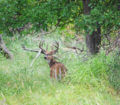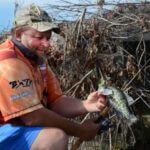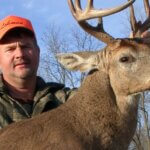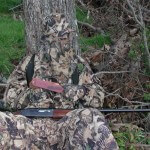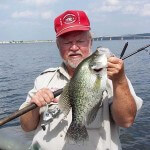Editor’s Note: Successful deer hunting involves problem solving and decision making. But to consistently succeed, you must know when to change strategies and why to abandon a hunt plan and have the flexibility to institute those changes. That’s what the deer-hunting pros do. Weather, hunting pressure, the availability of food, the rut and your intuition all determine how, when and where you should hunt.
 Rick Clunn, one of America’s best bass fishermen, has won the Bassmaster Classic four times. When someone asks Clunn to name his favorite lure, Clunn always answers that, “The lure that’s catching bass on that day. I select my baits and the type of pattern I’m going to fish each day, depending on the wind and the weather conditions, and what the bass are doing. To consistently catch bass, you have to be willing to change methods to adapt to the changing conditions on the lake.” Like the consistently-successful bass angler, the deer hunter who wants to increase his odds of bagging a buck on every outing will let the weather conditions, the terrain and the amount of hunting pressure determine where, when and how he hunts. Let’s look at what often dictates the most productive style of hunting on any given day.
Rick Clunn, one of America’s best bass fishermen, has won the Bassmaster Classic four times. When someone asks Clunn to name his favorite lure, Clunn always answers that, “The lure that’s catching bass on that day. I select my baits and the type of pattern I’m going to fish each day, depending on the wind and the weather conditions, and what the bass are doing. To consistently catch bass, you have to be willing to change methods to adapt to the changing conditions on the lake.” Like the consistently-successful bass angler, the deer hunter who wants to increase his odds of bagging a buck on every outing will let the weather conditions, the terrain and the amount of hunting pressure determine where, when and how he hunts. Let’s look at what often dictates the most productive style of hunting on any given day.
Still-Hunting:
Because undisturbed deer will travel the same trails, bed in the same thickets and feed-on the same food sources each day, you can still-hunt or stand-hunt them for the most success. The still hunter bets a buck is a creature of habit and that he will do the same thing today he has done yesterday. If you get to hunt undisturbed deer, this tactic will pay buck dividends. Stand-hunting and still-hunting also are very effective when you discover the escape trails deer utilize to dodge hunting pressure. If you can find a creek crossing or a trail leading out of heavy cover in areas of high hunting pressure, then you may bag a buck when other hunters disturb those animals. Too, still-hunting may produce deer when you take a stand on the edge of a bedding area to find deer coming either to their beds in the mornings or leaving their beds late in the afternoon.
 Stalk-Hunting:
Stalk-Hunting:
Stalk-hunting is almost a lost hunting art. Society has taught us all that the faster we go, and the more ground we cover, the quicker we get whatever we’re trying to obtain. However, you’ll not find this philosophy true when applied to deer hunting. A consistently-successful stalk-hunter often will cover no more than 50 to 100 yards in an hour. This man realizes that the slower he goes, the more deer he sees. The stalk-hunter also must be conscious of hunting into the wind. If the wind changes directions, he generally will alter the direction of his stalk.
The successful stalk-hunter hunts one-footed. He places his heel on the ground and then slowly rocks his foot forward, feeling every stick and branch under his foot. If he feels a twig that will pop, he’ll readjust his foot to dodge the sticks. Then he won’t break the twig before he shifts his weight to stand on that foot. Once he’s shifted his weight to the foot he’s just put down, he’ll raise the other foot off the ground and slowly move it forward, repeating the same precise step that he has made before. Most of the time, he’ll have all the weight of his body on one foot.
At the same time the stalk-hunter takes these slow, deliberate steps, he looks in all directions for the swish of a tail, the inside white of a deer’s ear, the black circle of a deer’s eye or the parallel line about three feet off the ground of a deer’s back. Once he spots the animals, he slows his stalk down, analyzes what the deer are doing and where they want to go and determines where he must stand to make the shot.
The best weather conditions for stalking include the times . . .
- after a rain when the ground is wet and the leaves won’t pop and crack under your feet;
- during a rainstorm when the wind and the rain can hide your movements and the sound of your walking; and/or
- on wet, windy days when the wind will disguise your movement and the sound of your walking.
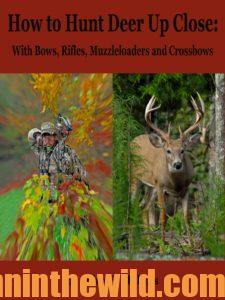
 To learn more about hunting deer, go to John E. Phillips’s book, “How to Hunt Deer Up Close with Bows, Muzzleloaders and Crossbows” https://www.amazon.com/dp/B00A2A6ZG6#. To receive your free book on “How to Make Venison Jerky,” go to https://www.emailmeform.com/builder/form/Ece3UZVcOo52cKPJcL.
To learn more about hunting deer, go to John E. Phillips’s book, “How to Hunt Deer Up Close with Bows, Muzzleloaders and Crossbows” https://www.amazon.com/dp/B00A2A6ZG6#. To receive your free book on “How to Make Venison Jerky,” go to https://www.emailmeform.com/builder/form/Ece3UZVcOo52cKPJcL.


